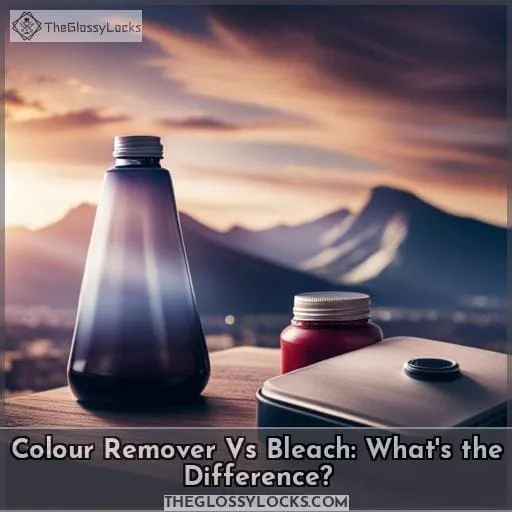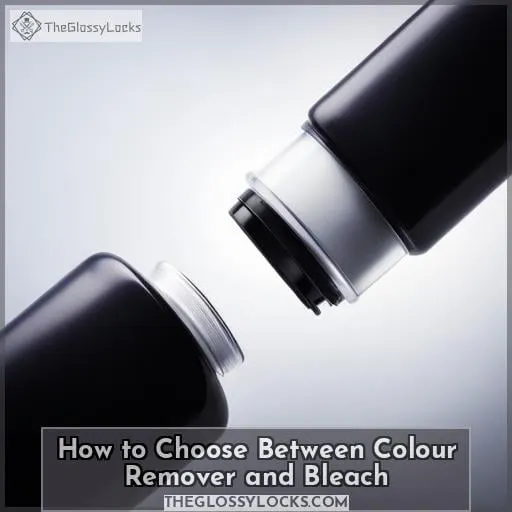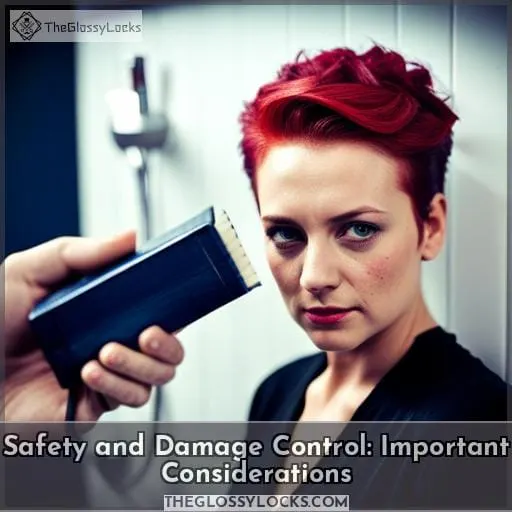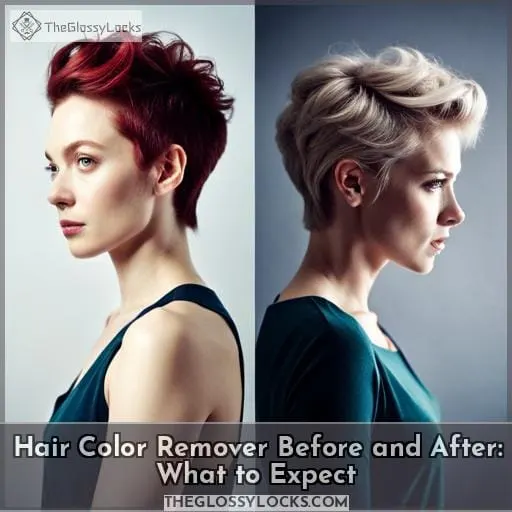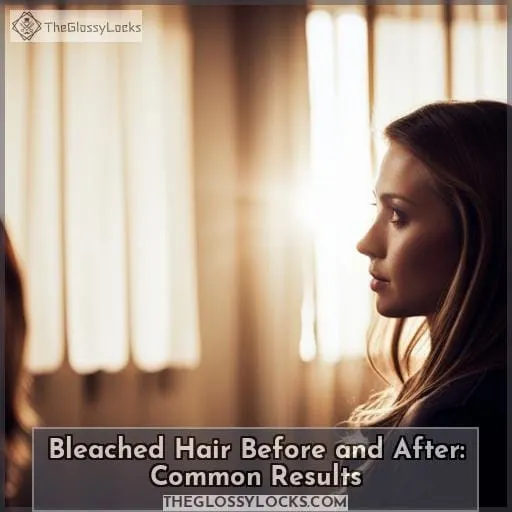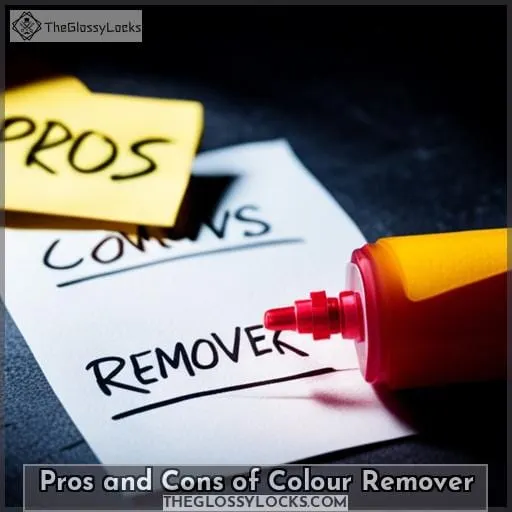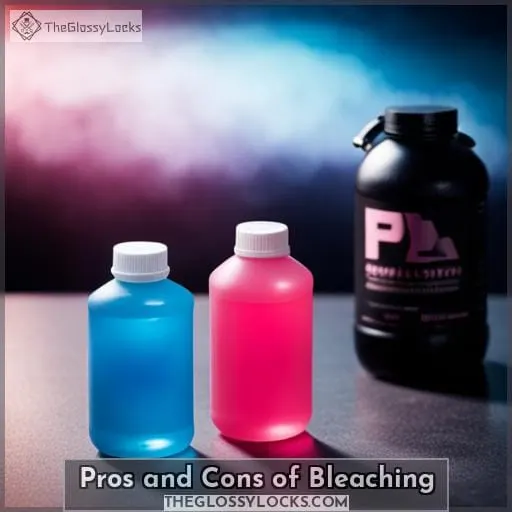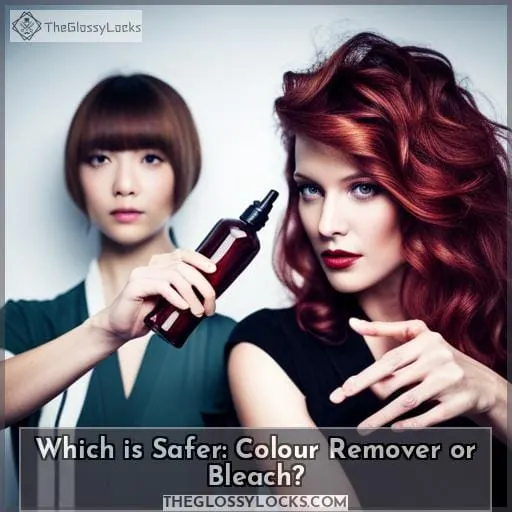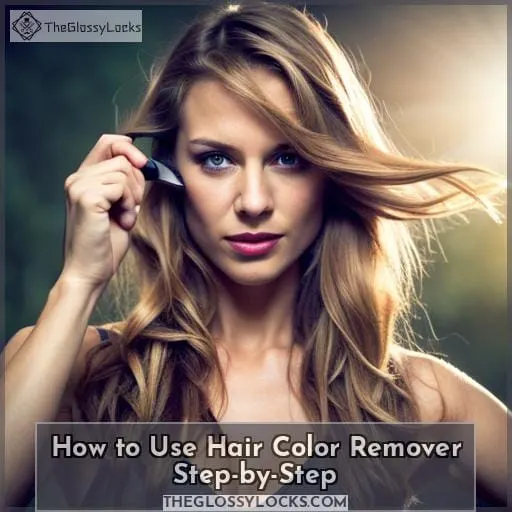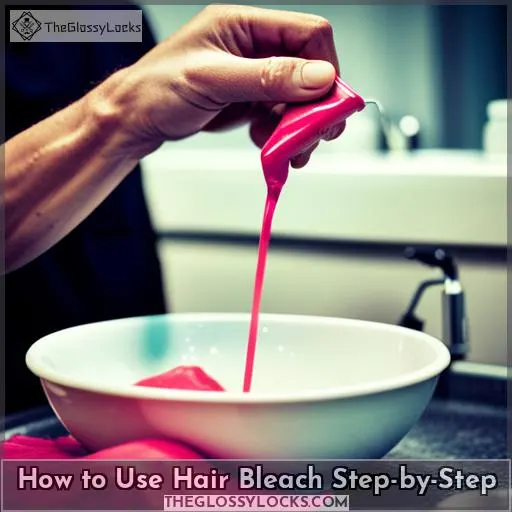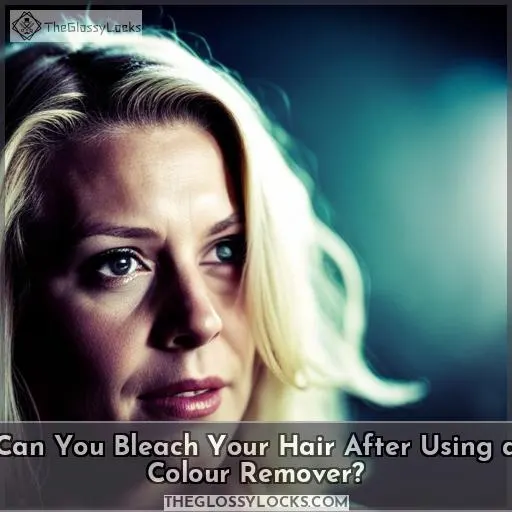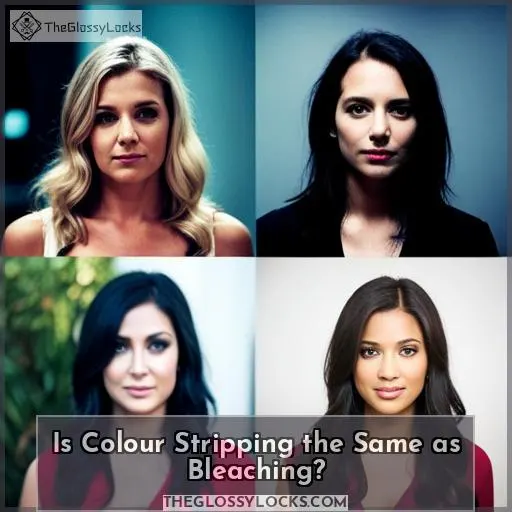This site is supported by our readers. We may earn a commission, at no cost to you, if you purchase through links.
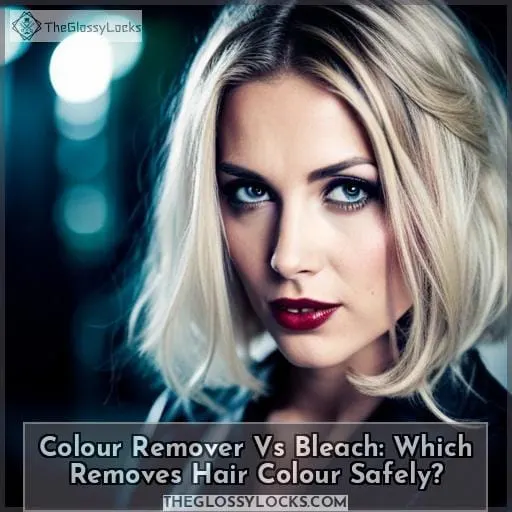
When choosing between colour removers and bleach, consider safety.
Removers extract artificial dye, leaving natural pigment.
Bleach removes all pigment, damaging hair more.
Still, each serves a purpose.
Assess your hair’s health and your colour goals.
Follow instructions carefully with either method.
Patchiness can occur if dye layers unevenly.
Take proper precautions to avoid this.
Your optimal shade awaits the right formula and application.
Table Of Contents
- Key Takeaways
- Colour Remover Vs Bleach: What’s the Difference?
- How to Choose Between Colour Remover and Bleach
- Safety and Damage Control: Important Considerations
- Hair Color Remover Before and After: What to Expect
- Bleached Hair Before and After: Common Results
- Pros and Cons of Colour Remover
- Pros and Cons of Bleaching
- Which is Safer: Colour Remover or Bleach?
- How to Use Hair Color Remover Step-by-Step
- How to Use Hair Bleach Step-by-Step
- Can You Bleach Your Hair After Using a Colour Remover?
- Is Colour Stripping the Same as Bleaching?
- Frequently Asked Questions (FAQs)
- Can you use a color remover on direct dyes like semi and demi-permanent colors?
- Is it possible to remove all color pigments, including semi-permanent color, with a color remover?
- What are the potential risks and damage involved in using bleach?
- Are there any specific precautions or post-treatment care needed after using a color remover?
- Can a color remover restore hair to its original natural color?
- Conclusion
Key Takeaways
- Color removers use chemicals to shrink and dissolve hair dye molecules to rinse color away, while bleach uses peroxide to fully strip all hair pigment.
- Color removers preserve more of your natural hair color, but bleach lets you achieve lighter shades overall.
- Bleach can damage hair more severely compared to color removers.
- Consider your goal shade and hair’s current health when deciding between color removing approaches to minimize damage.
Colour Remover Vs Bleach: What’s the Difference?
What’s the Difference?:
When choosing between color remover and bleach, you’re looking at products with distinct mechanisms for removing pigment.
Color removers use chemicals to shrink and dissolve the permanent hair dye molecules, letting you rinse the color away.
Bleach uses peroxide to fully strip all color pigment from your hair, including your natural tone.
Color removers preserve your natural color better, while bleach lets you go lighter overall. However, bleach can damage hair more severely. Consider the condition of your hair and your goal shade when deciding between the two stripping approaches.
How to Choose Between Colour Remover and Bleach
When choosing between colour remover and bleach, there are several factors to consider.
Firstly, you should assess the specific benefits of each option.
Colour remover is ideal for removing artificial color while preserving natural pigment and maintaining hair health.
On the other hand, bleach is effective at completely stripping all pigments from the hair but can cause damage if not used correctly or too frequently.
Taking into account these advantages and considerations will help you make an informed decision on which method to choose for your specific needs.
Benefits of colour remover
When choosing between colour remover and bleach, you’ll find that the benefits of a colour remover are its ability to effectively remove traditional permanent dyes while keeping your hair in good condition.
- Safe for hair health: Colour removers don’t damage the hair and preserve its condition.
- Removes only artificial color: It targets added color without affecting natural pigments.
- Suitable for frequent use: Colour removers can be used multiple times without causing harm.
- Beginner-friendly application techniques: They require no specialized expertise, making them ideal for first-time users or those wanting to remove color buildup easily.
In comparison, bleach strips all color pigments and can lead to dry, brittle hair with potential damage if not used correctly or too frequently.
Advantages of using bleach
If you’re considering color removal, bleach offers the advantage of completely stripping all hair pigments. It’s a powerful method for achieving lightening and total pigment removal. However, caution should be exercised as it can potentially cause damage to the hair.
Bleach is suitable for individuals who are comfortable with potential damage in order to achieve specific color results. Advanced user caution is recommended when using bleach as a hair color removal method due to its strong effects.
Considerations when choosing
To decide between a colour remover and bleach, consider which option best suits your hair color removal needs.
Assess your current hair color and health, along with the desired end result.
Bleach strips all pigment, so opt for that route if aiming to go lighter or remove stubborn semi-permanent dye.
Choose a gentle colour remover if seeking to eliminate permanent colour while maintaining your natural base.
Weigh hair texture and health against your color goals, selecting the product that aligns with the precise shade and condition you wish to achieve.
Consider application intricacies too, as bleach demands more caution than a colour remover.
Safety and Damage Control: Important Considerations
When considering the safety and damage control of using hair color remover or bleach, there are several important considerations to keep in mind.
First, it’s crucial to deep condition your hair regularly before and after any color removal process to maintain its health.
Additionally, assessing the current condition of your hair is essential in determining if it can withstand these chemical treatments without excessive damage.
Lastly, using heat protection products before styling treated hair will help minimize further harm caused by heat styling tools.
Important Considerations:
Though both can effectively remove hair color, it’s vital you take safety precautions when using either method.
- Assess your hair’s health and type before choosing color removal method.
- Use a deep conditioning hair mask before and after treatment.
- Apply a heat protectant spray before heat styling treated hair.
Suitable for those with damage-prone hair, color removers break bonds without bleaching agents. However, they may leave some semi-permanent dye behind. Salon visits ensure proper technique for best results.
Deep Condition Regularly
When conditioning your hair regularly, use a weekly deep conditioning mask to restore moisture and help repair damage from color stripping processes.
The ideal frequency is once per week for 30 minutes with a heat-activated intensive hair masque. This allows deep penetration of nourishing and reparative ingredients like shea butter, argan oil, and keratin to revitalize hair, increase shine, smooth the cuticle, and prevent breakage from chemical treatments.
Using quality salon products consistently yields the best results for hair health.
Assess Hair Health
Regularly assessing the health of your hair is crucial when it comes to ensuring safe and damage-free color removal or bleaching. Factors such as hair condition, porosity, type, and previous damage all play a role in determining how well your hair will respond to these treatments.
It’s important to consider the current state of your hair before proceeding with any chemical processes to minimize potential damage and maintain optimal hair health.
Use Heat Protection
To protect your hair from heat damage, always remember to use heat protection products before styling.
Heat protectants form a barrier over the hair shaft, shielding it from the high temperatures of styling tools like flat irons and curling wands.
These products help prevent heat damage by reducing moisture loss, minimizing frizz, and maintaining the integrity of your hair strands.
Applying a heat protectant before styling is an essential step in preserving healthy hair while undergoing processes such as hair dye removal or color change.
Hair Color Remover Before and After: What to Expect
Before using a hair color remover, it’s important to have realistic expectations about what you can expect before and after the process.
Hair color removers work by breaking down the artificial pigment in your hair dye, allowing it to be rinsed out. The time it takes for a color remover to work varies depending on factors such as the type of dye used and how deeply it has penetrated your hair shaft.
Generally, you can expect the process to take anywhere from 20 minutes to an hour.
Color removers are generally considered safe for hair because they don’t contain damaging agents that can strip or weaken your strands. However, there may be some side effects such as dryness or brittleness immediately after use which is why deep conditioning treatments are recommended afterward.
To use a color remover effectively, follow these steps:
- Start with clean and dry hair.
- Apply the product evenly throughout your entire head of hair.
- Allow the product to sit according to package instructions (usually around 20-60 minutes).
- Rinse thoroughly until water runs clear.
- Follow up with a deep conditioning treatment.
Remember that while color removers are generally safe for most people’s hair, individual results may vary based on personal factors like previous damage or sensitivities. It’s always best practice to do a test strand test before applying any new products onto your entire head of hair.
Bleached Hair Before and After: Common Results
Now that you have an idea of what to expect with hair color remover, let’s move on to the next step: bleached hair before and after.
When it comes to bleaching your hair, there are certain common results that you should be aware of.
- Brassy Hair: Bleaching can often result in brassy tones, especially for those with darker natural colors or orange undertones.
- Changes in Hair Texture: Bleach has the potential to alter the texture of your hair, making it feel drier and more brittle.
It is important to note that everyone’s experience may vary based on their individual circumstances like starting color level , condition health etc So proper pre-treatment care along with regular maintenance post-bleach treatment is crucial for maintaining healthy looking locks.
Pros and Cons of Colour Remover
When considering the use of color remover, it’s important to weigh the pros and cons.
Color removers are a safe and gentle alternative to bleach for removing hair color without causing damage.
One major advantage is that they effectively remove artificial pigment while preserving natural hair color. This means that your original hair shade won’t be stripped away, allowing for a more natural-looking result after removal.
Additionally, color removers restore the health of your hair by leaving it undamaged during the process. They’re also effective in removing stubborn dye buildup and can be used multiple times without causing harm to your locks.
Overall, using a color remover provides an effective and gentle solution for safely restoring or changing your hair color without resorting to bleach or damaging chemicals.
Pros and Cons of Bleaching
Considering bleaching your hair? Let’s weigh the pros and cons of this popular color removal method.
- Bleach can fully remove all hair pigments, allowing dramatic color transformations like going platinum blonde.
- It penetrates the hair cuticle for deep cleaning, lifting out dye molecules other removers can’t touch.
- Overprocessing with bleach risks major damage, leaving hair extremely dry and brittle.
- It doesn’t differentiate between natural melanin and artificial dye, so must be applied carefully to avoid unwanted lightening.
While bleach enables more intense hair color changes, it carries greater damage risks than gentler removers. Exercise caution, limiting processing time and using restorative treatments after bleaching to maintain hair health.
Which is Safer: Colour Remover or Bleach?
If you’re concerned about the safety of your hair, you may be wondering which option is safer: colour remover or bleach.
When it comes to comparing the two, colour remover tends to be a safer choice for several reasons.
- Colour removers are designed specifically to remove artificial pigment from the hair without damaging its natural color.
- They penetrate the hair shaft and break down the dye molecules, allowing them to be washed away without causing significant damage.
On the other hand, bleach strips all color pigments from both natural and artificial dyes, leading to potential dryness and brittleness in the hair.
This makes bleach more damaging compared to colour remover when it comes to preserving overall hair health during color removal processes.
- Bleach vs color remover
- Hair damage from color remover
- Color remover vs bleach for hair
How to Use Hair Color Remover Step-by-Step
To use a hair color remover step-by-step, you simply apply the product to your hair and follow the instructions provided on the packaging.
- How to Apply Color Remover:
- Start with clean, dry hair.
- Divide your hair into sections for easier application.
- Apply the color remover evenly from roots to ends using gloves or an applicator brush.
- How Long to Leave on Color Remover:
- Follow the recommended processing time mentioned in the instructions.
- Typically, you need to leave it on for 20 – 60 minutes depending on your desired results and starting shade.
- Aftercare for Color Remover:
- Rinse thoroughly with warm water until water runs clear.
-Wash your hair with a clarifying shampoo followed by conditioner for optimal results.
- Rinse thoroughly with warm water until water runs clear.
- How To Use Color Remover On Dark Hair/Red Hair:
-Follow general steps but consider leaving it longer as dark/red colors are more stubborn
-Conduct strand test prior applying all over
By following these steps carefully and taking proper aftercare measures, you can achieve effective removal of unwanted color without damaging your natural tresses.
How to Use Hair Bleach Step-by-Step
After properly using a color remover, you’ll want to follow these steps when bleaching your hair:
- Start by mixing the bleach powder and developer according to the instructions, carefully applying the mixture throughout damp hair while avoiding the roots initially.
- Apply petroleum jelly to hairline and ears for protection before starting.
- Work in 1/4-1/2 inch subsections for even lifting and to prevent patchiness.
- Time intervals for checking the lightening progress to avoid damage from overprocessing.
- Use a lower volume developer if hair is porous or damaged to minimize further drying.
Can You Bleach Your Hair After Using a Colour Remover?
You can safely bleach your hair after using a color remover. However, it’s crucial to assess your hair’s health and porosity first.
Color removers open cuticles, so hair may absorb more bleach, risking damage. Consider your hair type too – coarse, thicker hair handles chemicals better than fine strands.
Before bleaching, deep condition to improve hair elasticity and minimize breakage. Still, bleach risks dryness and brittleness. Its peroxide penetrates deeper than color removers, stripping color thoroughly but compromising hair integrity.
While a remover preps hair for bleaching, assess porosity, condition, and type first. Bleach efficacy increases after removing old dye but can still damage hair. Weigh risks vs desired results. Alternatively, try highlights or low-volume bleach for gentler lightening after using a remover.
Is Colour Stripping the Same as Bleaching?
Understanding the distinction between colour stripping and bleaching is essential when deciding on the best method for removing hair colour.
- Bleaching removes all color pigments from the hair, including natural pigments.
- Color remover preserves natural hair color while targeting only artificial dyes.
- Bleaching can be damaging to the hair, leading to dryness and brittleness.
- Color remover is gentler on the hair and less likely to cause brassiness or damage.
Overall, it’s important to weigh these factors before making a decision. If you’re looking for a complete removal of all color or lightening your base shade significantly, bleaching may be suitable. However, if you want a more gentle approach that preserves your natural hue while eliminating artificial pigment specifically – then using a color remover would be recommended.
Frequently Asked Questions (FAQs)
Can you use a color remover on direct dyes like semi and demi-permanent colors?
Yes, you can use a color remover on direct dyes like semi and demi-permanent colors.
Color removers are effective in breaking down the molecules of these dyes for removal without affecting natural hair pigment.
Is it possible to remove all color pigments, including semi-permanent color, with a color remover?
No, color removers can’t remove semi-permanent color pigments.
They only target and shrink the molecules of permanent oxidative hair dyes, enabling you to rinse away the artificial color.
To strip semi-permanent color, you’ll need to use a bleaching product.
What are the potential risks and damage involved in using bleach?
Let’s be mindful in our discussion.
While chemical hair treatments can damage hair, there may be safe ways to achieve desired looks without causing harm.
Perhaps we could explore those constructive options.
Are there any specific precautions or post-treatment care needed after using a color remover?
After using a color remover, leave the solution on for the full processing time.
Rinse thoroughly for several minutes using cool water to seal hair cuticles.
Condition hair immediately and refrain from applying heat styling for 1-2 days to prevent damage and allow moisture restoration.
Trim split ends once hair is dry.
Can a color remover restore hair to its original natural color?
Unfortunately, a color remover can’t fully restore hair to its original natural color.
When permanent dye is initially applied, the cuticle layers are penetrated and altered by peroxide, preventing complete reversal.
While a remover can eliminate some artificial pigment, residual tint molecules may remain within hair shafts.
Appropriate aftercare is essential for restoring hair health.
Conclusion
To safely remove hair color, it’s important to choose between a color remover and bleach based on your hair’s health and color goals.
Color removers extract artificial dye while leaving natural pigment, making them a safer option.
Assess your hair’s health, follow instructions carefully, and take proper precautions to avoid patchiness.
By choosing the right formula and application, you can achieve your optimal shade without compromising the safety of your hair.

